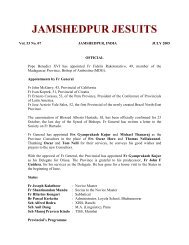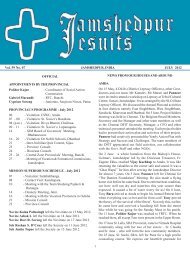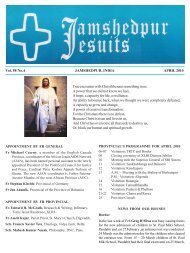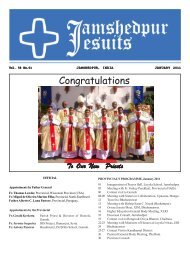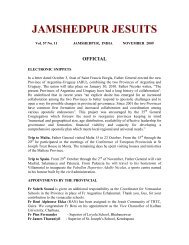Click here to download - Jamshedpur Jesuits
Click here to download - Jamshedpur Jesuits
Click here to download - Jamshedpur Jesuits
Create successful ePaper yourself
Turn your PDF publications into a flip-book with our unique Google optimized e-Paper software.
Cover Feature<br />
does not undermine and, much less,<br />
eliminate the role and importance of<br />
God in creation. What science has<br />
done is <strong>to</strong> make known the ingenious<br />
way God has fashioned our fabulous<br />
universe, inviting us even more urgently<br />
<strong>to</strong> appreciate and admire the wisdom<br />
and power of God. Even if humans one<br />
day become capable of recreating fully<br />
the Big Bang event, the importance of<br />
the uniqueness of the original creation<br />
remains, because what science can<br />
do will only a duplication. Making<br />
a duplicate is a matter of imitation,<br />
w<strong>here</strong>as making the original involves<br />
originality and creativity.<br />
Creation, as unders<strong>to</strong>od<br />
traditionally, involves bringing<br />
something out of nothing, not<br />
transforming something out of what<br />
is already existing. The Crea<strong>to</strong>r needs<br />
no raw material <strong>to</strong> work with. On the<br />
other hand, what science does is <strong>to</strong><br />
use matter which has been invested<br />
with incredible capabilities <strong>to</strong> carry out<br />
certain operations. In the case of the<br />
LHR experiment almost infinite energy<br />
could be produced, because matter has<br />
already been invested with the capability<br />
by the Crea<strong>to</strong>r <strong>to</strong> produce infinite energy<br />
if and when it is enabled <strong>to</strong> move with<br />
the velocity of light. If matter did not<br />
already possess this incredible capability,<br />
no effort made by science would have<br />
produced the near-Big Bang condition.<br />
Hence science is severely limited by<br />
the raw material available <strong>to</strong> it and the<br />
capabilities these raw materials possess.<br />
Science’s role is confined <strong>to</strong> identifying<br />
the capabilities locked up in matter<br />
and making creative and ingenious use<br />
of them.<br />
b. Nature Outsmarting Science<br />
T<strong>here</strong> is another important<br />
consideration also, taken from the<br />
his<strong>to</strong>ry of science, which cannot be<br />
overlooked. The his<strong>to</strong>ry of modern<br />
science for the last four centuries<br />
shows that whenever science solves one<br />
mystery of nature with a groundbreaking<br />
discovery, several other puzzles seem<br />
<strong>to</strong> surface. For instance, When Lord<br />
Rutherford in1910 made his startling<br />
discoveries about the structure of the<br />
a<strong>to</strong>m, many thought that humans had<br />
resolved the puzzling questions of the<br />
structure of the a<strong>to</strong>m. But later his<strong>to</strong>ry<br />
has shown that it was but a simple and<br />
humble beginning of a whole world of<br />
knowledge and ideas concerning the<br />
a<strong>to</strong>m and material reality. A very similar<br />
situation arose in the world of biology<br />
when Watson and Crick discovered<br />
the structure of DNA in 1953, which<br />
also opened up a plethora of new<br />
puzzles challenging science. Many<br />
such cases can be cited from his<strong>to</strong>ry.<br />
Indeed, it is no exaggeration <strong>to</strong> say<br />
that when science successfully resolves<br />
one puzzling mystery of nature, several<br />
other related ones prop up seeking<br />
resolution. Nature seems <strong>to</strong> be having<br />
an inexhaustible s<strong>to</strong>re of mysteries and<br />
puzzles. It seems that nature can never<br />
be outsmarted by human ingenuity. This<br />
is what keeps science going; this is what<br />
makes science an exciting and rewarding<br />
experience. This is what keeps God and<br />
religion alive despite all the breathtaking<br />
breakthroughs <strong>to</strong> science’s credit.<br />
c. Supporting God and Religion<br />
More specifically, in the case<br />
of the discovery of the God particle<br />
and the developments associated<br />
with it, t<strong>here</strong> is an important positive<br />
development in support of God and<br />
religion. These developments are closely<br />
linked <strong>to</strong> the Big Bang Theory of Abbe<br />
Georges Lemaitre which was officially<br />
presented in 1931. Since, according <strong>to</strong><br />
the Standard Model, the Higgs bosons<br />
could be produced only in the near<br />
Big Bang condition, the success of the<br />
God particle project is an important<br />
addition <strong>to</strong> the overwhelming support<br />
Lemaitre’s theory has been receiving<br />
from the mid-1960s onwards. It is well<br />
known that the Big Bang Theory of the<br />
origin of the universe can argue for the<br />
existence of a divine Crea<strong>to</strong>r, since the<br />
cause of the Primeval A<strong>to</strong>m of the Big<br />
Bang is left open. In fact, this was the<br />
main reason why Fred Hoyle and other<br />
atheistic cosmologists opposed the<br />
theory of Lemaitre, and proposed their<br />
rival theory of the Steady State Theory<br />
of the origin of the universe. This new<br />
source of evidence for the Big Bang<br />
theory is lending further support <strong>to</strong><br />
the traditional view that the creation of<br />
the universe required an external divine<br />
agency (See edit on p.3).<br />
Conclusion<br />
The discovery of the God Particle<br />
is an outstanding achievement of<br />
contemporary science not only because<br />
of what it has already accomplished, but<br />
even more because of what it promises<br />
<strong>to</strong> do in the coming years. Far from<br />
being a source of unrest and alarm, this<br />
should be a source of joy for believers in<br />
the true God. As the Fathers of Vatican<br />
II reaffirmed in their “Closing Message<br />
<strong>to</strong> Scientists,” both true religion and<br />
genuine science share the common<br />
mission of the search for truth. Science<br />
is engaged in the search for truth assisted<br />
by the best of reason, true religion<br />
does the same with the special help of<br />
divine revelation. These two should<br />
not contradict, rather they should<br />
complement each other. Certainly<br />
recent developments in science have<br />
far-reaching consequences for religion,<br />
particularly in its understanding of the<br />
nature and role of God in the universe.<br />
In the light of the information and<br />
insights being revealed by contemporary<br />
science, some of the old ideas will<br />
have <strong>to</strong> be re-visioned; some others<br />
will have <strong>to</strong> be modified. This should<br />
come as no surprise. As the late Blessed<br />
Pope John Paul II wrote in 1988 <strong>to</strong> Fr.<br />
George Coyne, SJ, the then Direc<strong>to</strong>r of<br />
Vatican Observa<strong>to</strong>ry, “Contemporary<br />
developments in science challenge<br />
theology far more deeply than did<br />
the introduction of Aris<strong>to</strong>tle in<strong>to</strong><br />
Western Europe in the thirteenth<br />
century. Yet these developments also<br />
offer <strong>to</strong> theology a potentially important<br />
resource.” Instead of being alarmed<br />
by these developments, he held the<br />
hope that “the sciences of <strong>to</strong>day... may<br />
invigorate and inform those parts of<br />
the theological enterprise that bear<br />
on the relation of nature, humanity<br />
and God.”<br />
•<br />
Fr Job Kozhamthadam, SJ, is the President<br />
of Jnana Deepa Vidyapeeth in Pune. He can be<br />
contacted at: jobksj@gmail.com.<br />
JIVAN: News and Views of <strong>Jesuits</strong> in India OCTOBER 2012 9



